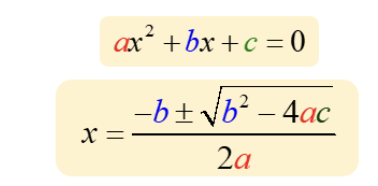functions + quadratics
1/16
There's no tags or description
Looks like no tags are added yet.
Name | Mastery | Learn | Test | Matching | Spaced |
|---|
No study sessions yet.
17 Terms
how to find the vertex
at²+bt+c
t = b/2a
substitute
e.g t²-3t = y
a = 1, b = 3
t = 3/2
(3/2)² - 3(3/2)
(9/4) - (9/2)
= -9/4
how to find range
insert endpoint of domain into the function
find the vertex
compare values, smallest is lowest possible value biggest is highest possible value
domain vs range
domain - possible x values
range - possible y values
quadratic formula
(-b ± square root of bsquared - (4ac))/2a

how do you know if 2 functions are inverse
if f(g(x))=x and g(f(x))=x f and g are inverse
domain + range of inverse functions
the domain of a function is the range of it’s inverse and vice versa.
vertex formula
((-b/2a),(c-(b²/4a)))
vertex form
a(x+p)²
how to find if functions are odd or even
function = f(x)
to find whether it is odd or even do f(-x)
if f(-x) = f(x) → even
if f(-x) = -f(x) → odd
if f(-x) does not = -f(x) or f(x) → neither
2 functions which are neither odd nor even but their product is even
f(x) = x-1
g(x) = x+1
f(x)g(x) = x²-1
domain restrictions
denominator cannot = 0
inside of square root has to be bigger or equal to 0
inside of log has to be bigger than 0
one to one function
above x-axis
discriminant
= b²-4ac
discriminant > 0
2 distinct answers/roots/solutions/x-intercepts
descriminant = 0
1 answer/repeated root/solution/x-intercept/equal roots
discriminant < 0
no real solutions
how to know if a function has an inverse or not
horizontal line test - If a horizontal line intersects two or more points anywhere on the graph, it is not invertible
in a table - if the same output shows up multiple times for different inputs, the function is not invertible.